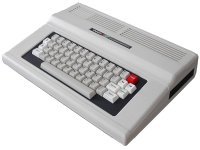Because that COCO2 I had seemed like a good working, solid machine.
I remember, I was able to type in some basic programs from a magazine.
Run them, and then save em onto floppy. It was straight forward…
I do know that i liked it more then the c64.
The major attraction of the CoCo compared to a C64, other than some esoterica related to the CPU, was that for programming/problem solving it was a much more "straighforward" machine. The Achilles heel of the C64 was that despite having nifty graphics and sound hardware the BASIC interpreter was *exactly the same version* as that used in a 1978 Commodore PET and thereby supported *none* of it. (If you wanted to make pretty pictures and noises from BASIC you had to learn how to POKE bits straight into the video memory and the VIC-II and SID chips.) The CoCo's graphics and sound hardware were much less impressive but they were easy to use, with BASIC commands to directly plot points, draw lines and shapes, etc.
sort of thing engineers and Ham Radio nuts appreciated.
Sorry I hate to sound like my 2 year old, but. Why?
I'm sure when you say it, there is a real concrete, well rounded meaning from your comment.
From what i know, Ham's and Engineers like to Tinker/Customize, Any connection?
The TRS-80 line used pretty vanilla hardware and in general the machines were not great choices for people that wanted a computer mostly to play video games. But the machines were well documented, widely available through a channel that "geeks" used to frequent (Radio Shack in the 70's-early 80's was a much different place than the zombie it is today), and the "vanilla-ishness" of their hardware made them easy for a person with the right skills to hack/customize/expand in nonstandard ways. The Apple II these days gets all the kudos for being "open" (history's written by the winners, after all) but there are parts of it that *are* proprietary (Tandys used bog-standard Shugart-interface disk drives for instance, not hacked mechanisms like Apple) and Apple IIs were *much* more expensive than the TRS-80s generally were. It was natural that the line attracted "cheapskate techy"-types.
(When the cheap Commodores like the VIC-20 and C64 came along they sort of shared the "cheap hackable niche" with the low-end Tandys, but I think it's fair to say there were subtle differences in the sort of person they appealed to. With their fancier-but-harder-to-access graphics the Commodores attracted "computer hackers" while the Tandy camp appealed to people who were out to solve technical problems that happen to involve computer hacking. If that makes any sense.)
6809 was rather quickly an evolutionary dead-end
Or was it that it was pleasing to use, for these guys because it was familiar due to it being a derivative of the 6800
http://en.wikipedia.org/wiki/Motorola_6800
And when these guys where in college getting their fancy degrees, They were around systems using the 6800 or the PDP-11 etc. ?
The deal with the 6809 was it was essentially the only 8 bit CPU that *really* supported modular, relocatable code without resorting to ugly hacks, and was considered to have an "elegant" instruction set. (Although it shared DNA with the 6800 it was *not* binary compatible with it and was basically better in every possible way; by comparison the competing Z-80 was a binary-compatible upgrade to the Intel 8080 with its extra registers and features "tacked on", which made its instruction set rather haphazard.) It offered *far* superior code density than the 6502 (the 6502 also had some onerous limitations relating to things like the size of the stack), and it had a multiply instruction, practically unknown amongst 8-bit CPUs. In short, there were things about it that appealed to computer science types.
Practically speaking the 6809 didn't give the CoCo any earth-shattering abilities beyond the reach of other home computers (as noted, the tradeoff in the CoCo's case for the nicer CPU was some pretty drab graphics hardware which at best could be charitably described as being about as good as the original Apple II's) but, you know, in the "mine is better than yours" pissing contests that inevitably broke out between the various home computer partisans it's pretty much *the* thing it had going for it.
Obscure trivia point, which you probably saw when you read the article, was that the Mac was originally slated to be based on the 6809. The 6809 is in fact arguably almost as "powerful" as the 68000 by some measures but it is ultimately hamstrung by its 64k native address space. Other obscure point was that, again, because of the 6809's ability to support modular code there *were* a number of "supermicros" (that SWTPC system you picked up in Florida is one) which used it to ran various "Unix-like" operating systems like UniFlex and OS-9. (There were multitasking OSes for the Z-80 and other CPUs as well, like MP/M, but they're in a number of ways less sophisticated.) The CoCo could actually run some stripped-down versions of these OSes, although that was really a niche thing in the CoCo community (I'd be *really* surprised if that kid or his dad was doing it), at least until the CoCo3 came along with the paged memory and 80 column screen hardware sufficient to make it worthwhile... but by that time the writing was clearly on the wall for the CoCo anyway.




